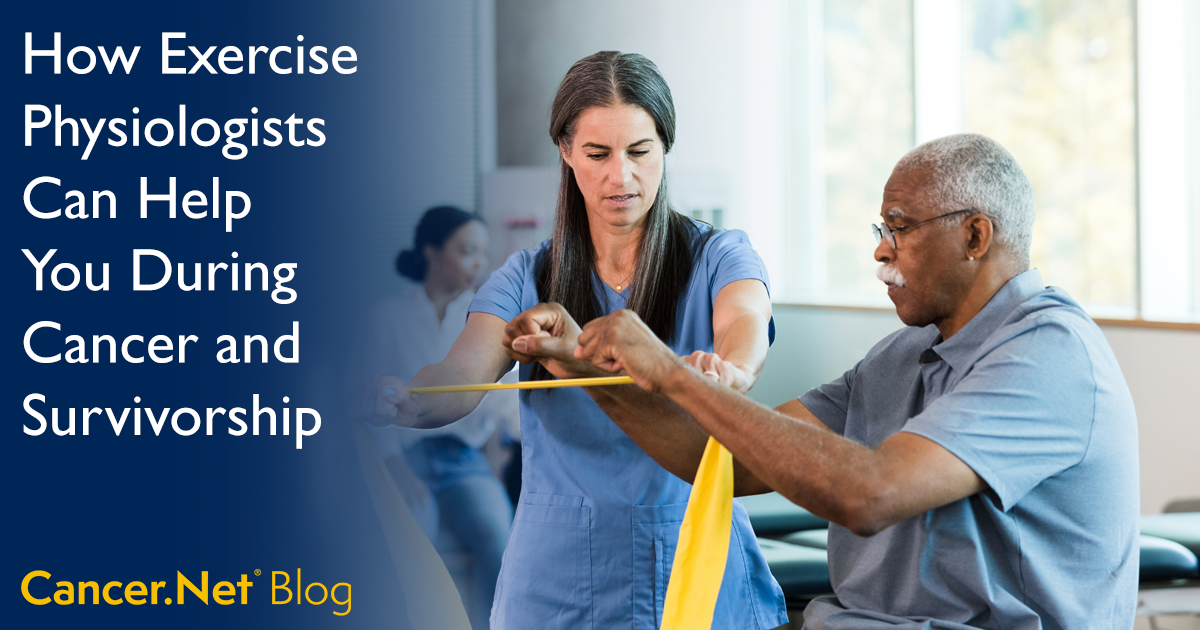
If you’ve been diagnosed with cancer, you will interact with a number of different members of the health care team at various times during treatment. When you walk into a doctor’s office, hospital, or cancer center, you may encounter nurses, physician assistants, social workers, doctors—the list goes on. In the Spotlight On series, we talk with some of these health care professionals to learn more about their jobs and the role they play in providing high-quality cancer care.
Danielle Halsey, MS, EP-C, is an exercise physiologist at the Indiana University Health Simon Comprehensive Cancer Center (IUSCC). She has worked with people with cancer since her time as an undergrad. Recently, she has been recruited to help develop a cancer rehabilitation program at IUSCCC. In her free time, she loves to bike, run, hike, lift, and spend time with her dogs and husband. She has competed in triathlons and powerlifting.
Cancer care teams have expanded to include new members in recent years. An exercise physiologist is one of the more recent additions in some care settings. Not many people with cancer meet this health care professional unless they enter pulmonary or cardiac rehabilitation. Yet, as the exercise oncology field grows, we see exercise physiologists being added to cancer care teams more and more often.
What role does an exercise physiologist play on the cancer care team?
DH: My role as an exercise physiologist on the cancer care team is like that of a physical therapist. But instead of assessing, diagnosing, and treating injury, I use the groundwork that a physical therapist has developed and build on that through cancer rehabilitation. Cancer rehabilitation programs aim to help people with cancer maintain or improve their physical function and health. This is accomplished by providing my patients with an exercise prescription. An exercise prescription is a fitness plan tailored to the patient’s individual goals, needs, and fitness level.
Over time, the fitness plan then progresses to work on continuing to improve the patient’s health. The American Cancer Society recommends that cancer survivors complete at least 150 to 300 minutes of moderate cardio activity or 75 to 150 minutes of vigorous activity per week, as well as 2 days a week of resistance training. My role as an exercise physiologist is to help educate and guide patients on accomplishing this recommendation and monitor patients during structured exercise sessions.
What are some of the most important things you do for people with cancer in your role?
DH: Meeting the recommended activity guidelines can be overwhelming and challenging, so my job is to make that goal more manageable for my patients. This is done by slowly progressing patients from easy cardio to more moderate exercise. Additionally, I will increase the duration and intensity of the exercise as they improve their fitness. While implementing the exercise program is the primary goal of my position on the care team, the most important things I provide are encouragement, support, and confidence. After treatment, many people with cancer just want to feel like themselves again. I have seen many patients find new confidence, pride, and strength through exercise.
What are some common concerns your patients have, and how do you help address them?
DH: Getting started with exercise can be intimidating no matter who you are, but the first step is just starting. When it comes to cancer survivors, many people don’t know what is safe, how much they should be doing, or what they should be doing. That’s where I come in.
For individuals trying to work out at home, I suggest they start with walking at least 3 to 5 days a week, building up to 30 minutes or more. This walk should be somewhat challenging, but still at a speed where you can have a conversation. If you cannot do 30 minutes, start with 10 minutes and progress in 2- to 5-minute intervals. Once they can consistently get some form of daily movement going, I suggest patients add in resistance training. This can be done with bodyweight exercises at home, machines in the gym, free weights, or even using items you have around your house. Resistance training should be done at least 2 times a week and include both the upper and lower body. You should perform at least 2 sets of 8 to 12 reps of various exercises.
This can be a lot to manage independently, so an exercise physiologist can help by developing a program specifically for you and your side effects, limitations, and access to equipment.
What is 1 thing that people with cancer should be aware of when it comes to exercise?
DH: “I am just tired all the time” is a common phrase among my patients who have cancer. It can be counterintuitive, but there is strong evidence to show that 3 sessions a week of 30 minutes of moderate cardio and 2 days a week of resistance training can help improve cancer-related fatigue. Additionally, exercise has been shown to improve quality of life, anxiety, depression, and physical function. And as an exercise physiologist, I can state I have seen these changes happen in all of my patients after just a few weeks of regular exercise. It may be a challenge at first, but once you get started, you won’t believe what you can do.
The author has no relevant relationships to disclose.








